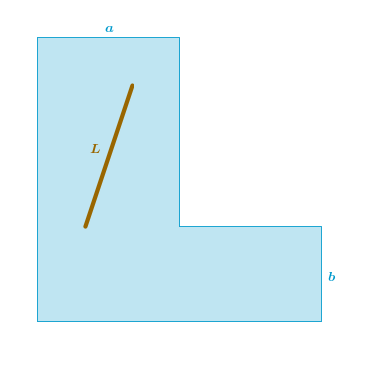 Author
Author |
Topic: William the Logger (Read 489 times) |
|
rloginunix
Uberpuzzler
    

Posts: 1029
|
 |
William the Logger
« on: Apr 1st, 2015, 6:43pm » |
 Quote Quote  Modify Modify
|
William the Logger.
Down the Math River that has parallel banks and a width a Willy Wu is floating logs which can be approximated as absolutely rigid line segments. At some point the river makes a ninety-degree turn and while its banks remain parallel its width is now b:

For a given a and b what is the longest log L can William safely float around the bend in such a way that the log does not get bent, broken, stuck, submerged below or popped above water (when only 2-dimensional transformations are allowed)?
Put it another way. If William knows a, b and L ahead of time when should he make the trip?
|
|
 IP Logged IP Logged |
|
|
|
jollytall
Senior Riddler
   

Gender: 
Posts: 585
|
 |
Re: William the Logger
« Reply #1 on: Apr 1st, 2015, 9:45pm » |
 Quote Quote  Modify Modify
|
First idea:
Make the log in alpha degree compared to the horizontal line, when it is almost stuck. Then the "corner" splits it into two parts, x across river a and y across river b.
x*cos(alpha) = a
y*sin(alpha) = b
The log is a/cos(alpha)+b/sin(alpha)
The minimum of it is when the derivative is 0, i.e.
-a*cos(alpha)/sin2(alpha)+b*sin(alpha)/cos2(alpha)=0.
tg(alpha) = (a/b)^(1/3)
From alpha x+y = L can be calculated.
|
|
 IP Logged IP Logged |
|
|
|
pex
Uberpuzzler
    

Gender: 
Posts: 880
|
 |
Re: William the Logger
« Reply #2 on: Apr 1st, 2015, 10:06pm » |
 Quote Quote  Modify Modify
|
on Apr 1st, 2015, 9:45pm, jollytall wrote:First idea:
Make the log in alpha degree compared to the horizontal line, when it is almost stuck. Then the "corner" splits it into two parts, x across river a and y across river b.
x*cos(alpha) = a
y*sin(alpha) = b
The log is a/cos(alpha)+b/sin(alpha)
The minimum of it is when the derivative is 0, i.e.
-a*cos(alpha)/sin2(alpha)+b*sin(alpha)/cos2(alpha)=0.
tg(alpha) = (a/b)^(1/3)
From alpha x+y = L can be calculated. |
|
That's pretty much what I did. The result is rather cute: L = (a2/3 + b2/3) 3/2.
|
|
 IP Logged IP Logged |
|
|
|
rloginunix
Uberpuzzler
    

Posts: 1029
|
 |
Re: William the Logger
« Reply #3 on: Apr 2nd, 2015, 9:28am » |
 Quote Quote  Modify Modify
|
You guys are both correct and what is rather amazing is that I took exactly the same route. Interesting.
There is also a more analytic (academic) approach, if you will: the orthogonal banks are actually the XOY axes. The log must slide along both playing a role of a tangent to some curve. So the question is - find the curve the length of tangent to which trapped between the axes is constant at all times. If the (a,b) corner is inside that curve - no go. Pythagoras and an equation of a straight line lead to a differential equation in this case.
Turns out that the equation given by pex describes a curve known as astroid.
Well done.
(I interpreted jollytall's last equation like so: tg( ) is almost a derivative, for it to be a real one the angle must be ) is almost a derivative, for it to be a real one the angle must be  - -  and then we get a trivial differential equation dy/dx = -(y/x)1/3 ...) and then we get a trivial differential equation dy/dx = -(y/x)1/3 ...)
PS
This particular puzzle interconnects with A Cat on a Ladder and Infinite Fast Ladder in the easy section.
[edit]
Fixed two spelling errors.
[/edit]
|
| « Last Edit: Apr 2nd, 2015, 11:50am by rloginunix » |
 IP Logged IP Logged |
|
|
|
|
 WRITE MATH!
WRITE MATH!
 Home
Home  Help
Help  Search
Search  Members
Members  Login
Login  Register
Register WRITE MATH!
WRITE MATH!
 Home
Home  Help
Help  Search
Search  Members
Members  Login
Login  Register
Register